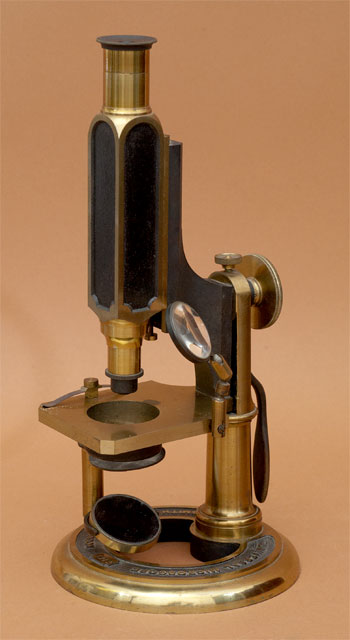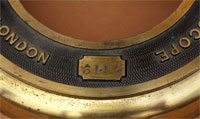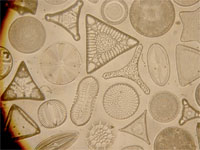 |
|||||
 |
 |
||||
 |
|||||
 |
 |
||||
The Smith Beck & Beck Universal microscope is best described by Richard Beck himself (The Achromatic Microscope, 1865):
"This instrument is the result of an endeavour to make a very low-priced Compound Achromatic Microscope by reducing its construction to the simplest possible form, still retaining all that a really useful instrument requires, together with such an arrangement as would admit of considerable additions being made without returning the stand to the makers."
The microscope is mounted to a circular main pillar that itself is mounted to a circular stand. The name "Smith Beck & Beck London" is molded into the base. At the top of the pillar is the mounting point for the body and focusing mechanism. The pivot allows the body to be tilted to a horizontal position. A small locking screw fixes the microscope at any position. Focusing is accomplished via a chain drive, with coarse focus being the typical brass knob. Fine focus is unique in that it uses a long lever to rotate the focusing shaft through much finer increments. The stage is rectangular with a large circular hole in the center. Originally the stage was topped with a curved brass plate and slide clip. The user would slide the plate on the stage top to finely adjust sample position.
Mounted to the side of the stage is a bull's eye lens for illuminating opaque samples. Below the stage is an aperture plate with shutter. The aperture was used at low magnification, but swung out of the optical axis for high magnification. The microscope came with five objectives that varied in magnification from 2 inches to 1/8 inch. Only the 1/4" objective remains. The eyepiece is of the achromatic Kellner design. Accessories include a stage forceps (missing), a brass forceps ("pair of pliers"), and a glass plate. The microscope comes with a mahogany case. Imaging is very good with little or no chromatic aberration.
James Smith (d1870), originally associated with J.J. Lister c1826, was a mathematical instrument maker in London. Lister's nephew Richard Beck (1827Ð1866) originally apprenticed with Smith, and in 1847 became Smith's partner. At that time the firm changed its name to Smith & Beck. Richard's brother Joseph (1829Ð91) joined the firm shortly after, having been an apprentice to Troughton & Simms, and became partner with Smith and Richard in 1857. The firm changed its name again to Smith Beck & Beck. This firm made a large number of scientific instruments at its factory "Lister Works" at Holloway, London. James retired in 1865, and the firm's name changed once again to R&J Beck and moved to Cornhill, London. From 1870 to 1885 the R&J Beck firm sold instruments in the United States through the firm of James W Queen & Co. of Philadelphia.
James Smith, Richard Beck and Joseph Beck were early members of the Royal Microscopical Society of London. The Golub Collection has examples of instruments made by Smith and Beck, Smith & Beck, Smith Beck & Beck (this instrument), and R&J Beck.
Microscope featured 11/2015


